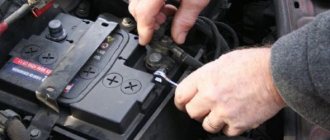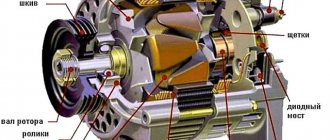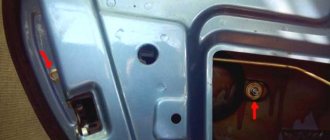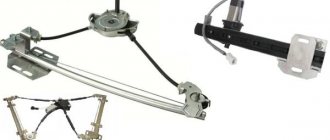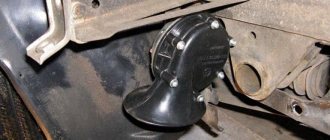Removing, disconnecting, connecting or replacing the battery - these tasks are performed by each car owner at a certain stage of vehicle operation, and are considered easy to carry out, which allows any person to cope with the task independently, even without specific knowledge and skills in working with equipment.
Despite the ease of implementation, incorrect manipulations can result in a number of problems related to the car and personal safety, which provokes the need to figure out how to properly disconnect, remove and install back the car battery so as not to harm the battery, the vehicle and yourself, which is what I’m talking about will be discussed later in the article.
Possible consequences of incorrectly disconnecting the battery
The reasons for the need to disconnect the battery can be different: from the banal need to replace an “outdated” battery with a new power source, to the need to turn off the power to the car while carrying out complex repair work. Often, questions related to battery removal are asked online, since the procedure is considered by many to be harmless and so elementary in execution that it is even “shameful” to say it out loud. In practice, a careless attitude towards the battery replacement process can result in very serious problems of various etiologies.
The task of removing the battery is indeed an easy one, and its execution requires only basic skills in working with a wrench and knowledge of the procedure, however, incorrect actions by the performer can cause unpleasant precedents, and even serious problems, with consequences such as:
- Battery failure or mechanical damage.
- Self-injury when performing careless actions, including when working without protective gloves and goggles, especially when spilling liquid in battery cans, which is classified as a toxic substance.
- A short circuit, as a result of which not only the vehicle’s wiring can be damaged, but also expensive on-board electronics, devices and accessories powered by the network.
The existing risks of harming the car or themselves oblige each car owner, before removing the battery, to study the technology of the procedure and strictly follow the work regulations established by the vehicle manufacturers.
What to do if the original battery is not enough
Modern cars already require multiple batteries. But so far this has been implemented in specialized vehicles and models with a powerful generator. The rest have to resort to makeshift methods to install an additional power source.
In most cases, the difficulty lies in choosing additional installation space and correct connection. The advantage of the method is obvious: By installing an additional battery, you can forget about frequent battery changes.
Car battery removal technology
Before you begin to understand the nuances of how to properly remove the battery from a car, you need to find where the battery is located in a specific car model. In the vast majority of cars, the battery is located in the engine compartment, to the right or left of the engine, closer to the windshield, however, such placement of the battery is not an established rule, and in some models it may be located in the luggage compartment, under the seats in the cabin or other, even unexpected “niches” of the car. You can find out where the battery is located by studying the owner's manual for the vehicle, by visually inspecting the car when instructions are not available, or by finding the answer on car forums if the first two options do not produce results.
The technology for dismantling the battery is almost identical for all brands and models of cars, however, in order to properly disconnect the battery, it is necessary to initially prepare the car for the procedure, as well as all the necessary tools and materials.
Preparing the car for the process of removing the battery consists of the need to turn off the engine, turn off all devices in the car that operate on voltage, remove the keys from the ignition and take them out of the car with you, in order to avoid the inability to get into the car if the lock is accidentally activated during the process of removing the battery.
Saving settings
There are many ways to do this. The most effective:
- Manufacturers have released systems that allow the electronics to remain on even when the battery is disconnected. All you need to do is connect the compact, easy-to-use device via the cigarette lighter socket. During use, the gadget blocks the engine from starting, and therefore the electronics will not turn on. Expensiveness is the only drawback of a “smart” device.
- The problem can be solved in a simpler and more accessible way. Namely: Connect the wire from any device, for example, charging a mobile phone or heating a seat, which previously operated from a device used to light cigarettes while driving in a car, to the Krona battery by inserting it into the cigarette lighter. You don’t have to worry about the safety of your settings for at least a couple of days. This time is enough to replace the old battery with a new one.
- The third, popular option is to use wires intended for lighting the cigarette and the “donor” car. Before removing the battery, the cigarette lighter wires are secured above the terminals of the battery being removed.
Installing the battery in the car
The reverse procedure, namely, the correct connection of the battery to the car after work has been completed or if it is replaced with a new unit, also requires compliance with the regulations. The first thing that the work contractor should take into account when installing the battery in a standard seat is its polarity: it is important to place the battery correctly in the car so that the positive “side” of the battery corresponds to the positive wire. It is worth noting that it will not be possible to connect the battery if it is installed inappropriately, since the negative terminal is much smaller than the positive docking mechanism; however, incorrect initial installation is an unnecessary and irrational waste of precious time and effort.
Installing a new battery
Once the old battery has been safely removed, you can begin installing the new battery.
- It is recommended to first inspect the battery area, removing dirt and debris with a soft cloth.
- Clean the inner surfaces of the wire tips with sandpaper - this will ensure good contact with the terminals. The wires can also be treated with a water-repellent liquid.
- The terminals themselves, which may have oxidized over a long period of time, are cleaned with a toothbrush dipped in a baking soda solution.
Restoring the on-board computer
When the car is de-energized, which occurs after the battery is disconnected, some vehicle models may simultaneously undergo zeroing of all electronic sensors and systems. A similar precedent is relevant for cars equipped with modern on-board computers, the settings of which are lost when the battery is removed, which calls into question the further functioning of the car in standard mode.
To resume on-board settings you will have to perform the following simple manipulations:
- After installing the battery, according to the regulations, turn on the ignition and warm up the engine to operating temperature.
- Remove the negative terminal for a few minutes, then fasten it back.
- Start the engine again and let it run for about fifteen minutes, which will allow the electronic systems to record information about the operation of the base sensors.
- Save the recorded information by simply turning off the ignition.
- Start the car again and check its operation in all operating modes. For this purpose, it is enough to perform a short “test drive” in safe conditions, with a gradual increase in speed, sharp acceleration and stopping, and then turning off the ignition, which will be the final stage of setup. Computer systems will automatically record the data obtained as a result of the test ride.
At this point, the restoration of on-board settings is considered complete, and the vehicle can continue to be operated in normal mode.
Selecting a battery when replacing
To replace it, it is better to choose exactly the same battery or, if they are not on sale, to choose a similar one.
The battery is selected according to the following criteria:
- Overall dimensions in plan must match and correspond to the installation location. The height may vary slightly, within the limits of the pressure bar adjustment;
- The design and dimensions of the terminals must be the same;
- The battery capacity should be the same as the standard one, you can only slightly increase it. For example, replace a battery with a capacity of 60 Ah with one of the same size, but with a capacity of 65 Ah.
- The polarity of the battery must correspond to that previously established, that is, the location of the positive and negative terminals on the case must be the same.
If on the side of the label (front) the negative terminal is located on the right, then this is direct polarity, if on the contrary, then it is reverse;
- The cold cranking current should be as high as possible;
- The manufacturer is preferably a well-known and proven one.
Summarizing
The information presented in the article will allow anyone, even a novice driver, to safely replace the battery, subject to all regulatory requirements for the procedure and the correct approach to performing the task.
If your car belongs to the category of elite class transport, is equipped with “complex” modern “brains”, then it is better to refrain from replacing the battery yourself, entrusting the work to specialists from car service stations, or, when the car is under warranty, contact an official service representative. Such a precaution will avoid the risk of “breakage” of the on-board computer, the cost of repairing which is far from being considered budgetary waste.
What will be required and safety measures?
The battery replacement operation is simple. As a tool, you will need a pair of open-end wrenches: 10 for the terminals and in most cases 13 for the battery mounts (there may be a different size depending on the car).
Be sure to wear gloves to protect your hands. If there are electrolyte leaks on the battery body, work with it wearing rubber gloves. Remember that the electrolyte is a solution of sulfuric acid. This is a caustic substance that may harm the skin and eyes.
avtoexperts.ru
Perhaps, few motorists have passed through this “chalice” - a battery that failed at the most inopportune moment. This situation is especially unpleasant in winter, when the battery is most exposed to critical temperatures and, having exhausted its reserve, is completely discharged. What to do in such a situation? There is only one answer: go to the nearest car store and buy a new battery. Once you purchase a battery, you will need to install it. There are two options - tow the car to the nearest service station, or replace the battery yourself. Everything is clear with the first option, but not everyone knows how to replace a car battery on their own. Today we will talk about this generally simple operation.
Let's start with the fact that you will have to purchase a battery that would be suitable in size and, most importantly, performance. You can buy exactly the same battery that was installed in yours, or you can buy one from a different manufacturer. It happens that it is difficult to find a complete analogue of your battery in a store, and therefore you have to choose from what is available. We will not name specific battery manufacturers - the leaders of this market can be found in any search engine. By the way, there you can also choose a battery that meets all your parameters, and also find out whether such a product is available in the store where you are planning to go to buy it.
Let's assume that the process of purchasing a battery was successful and you brought it to your car. Now let's install a new battery, first removing the old one. To do this, you will need wrenches of different calibers, a screwdriver and rubberized gloves. Before disconnecting and removing the failed device, let’s ask ourselves: does the car include equipment such as a radio, navigator, or on-board computer. If you have at least one of the listed devices, we recommend that you borrow another battery that can be used to power the listed car equipment. This must be done in order to avoid resetting all existing settings and then reprogramming and eliminating errors that may occur when the battery is “rebooted”. We connect the second battery before removing the old battery. Once backup power has been obtained, the spent battery can be removed. We do this in several steps:
1. Disconnecting terminals
. A 10mm wrench is usually suitable for this procedure, although some models may have different threads. Therefore, it is important to have a wrench with replaceable heads on hand.
In fact, there is no particular difference in whether we first disconnect the “positive” or “negative” terminal, but automotive electricians recommend starting with the “positive” one, since the electric current runs from the “positive” to the “negative” terminal.
2. Removing the old battery
. Different car models have different battery installations. It happens that to dismantle the battery, it is enough to remove the terminals, move apart the halves of the casing, which protects the battery from external influences, and, by pulling the handle, remove the device from the grooves. In many modern cars, the battery is screwed to the bottom of the casing (to ensure its stability), then you will have to work hard to unscrew the nut that “holds” the battery. To do this, you may need a wrench with a 13-mm head and an extension, with which you will need to unscrew the fastening nut. After this operation is completed, we move the halves of the casing apart and take out the battery. Remember that the battery weighs quite a lot (from 13 to 20 kg), so you may need outside help.
3. Installing a new battery . Before installing a new battery, it is necessary to clean the terminals that may have oxidized during long-term use (as a rule, new batteries operate for 4-7 years). We clean the terminals with an old toothbrush soaked in a solution of baking soda.
Battery terminals
After this, carefully install the new battery into the grooves, screw it on, check how firmly it fits into the groove by gently rocking it from side to side. Then we put on the terminals. If you first removed the “positive” and then the “negative” terminals, then first connect the “negative” terminal and then the “positive” to the new battery. To prevent the positive terminal from sparking when it comes into contact with the battery, we put a special plastic cap on it, which can be purchased with a new battery. To prevent the terminal fastenings from corroding, you can spray them with lithium grease (Litol-24). If your car is equipped with an alarm or central locking, you must open the car doors and remove the key from the ignition before installing a new battery.
After installing the battery, we check its operation. To do this, insert the key into the ignition, start the car and check the correct operation of all on-board electronics. By the way, you can find out how long, even approximately, a new battery will last - to do this, just look at the “minus” of the battery, where the manufacturer stamps two numbers, the first of which means a week (can be converted into a month), and the second - the year of production .
Read the article on how to charge a dead battery.
How to remove a battery with stuck terminals
It often happens that the terminals or one of them become oxidized (covered with a white coating). In this case, they must be cleaned with a brush before removal. It should be quite rigid, but not iron. In case of strong sticking, it is better to use a contact cleaner (ABRO, LIQUI MOLY), they are sold in all car dealerships. If there is no special product, you can simply clean the contacts and use WD 40 lubricant. The process looks like this:
- Treat the terminals with solvent.
- Carefully hook the bottom of the terminal with a screwdriver and wiggle it.
- Try to twist the terminals in different directions until you can remove them.
It is important to use minimal force during the process, otherwise the battery contacts may be damaged.
Important! Some owners tap the oxidized terminals with a heavy object to remove them. This should not be done under any circumstances. Due to such actions, the terminals may permanently fail or fall apart into small pieces.
What to do to prevent the terminals from sticking
To avoid sticking, the terminals should be treated with a protective agent. Of the modern compositions, the most popular are:
- Molykote HSC Plus is a high electrical conductivity product that operates at temperatures from -30 to +1100 oC;
- "Ciatim" - has good electrical conductivity characteristics at a low cost;
- German spray lubricant Liqui-Moly - protects well from oxidation and promotes stable voltage supply.
Drivers who prefer time-tested products opt for Litol or Negrol formulations. A mixture of grease and graphite lubricant also helps a lot.
Why change the battery
New car batteries can last from 5 to 7 years if used properly. After this period, the resource drops significantly, which is why the battery needs to be replaced. The performance of the battery is also affected by the degree of deep discharge - it depends on the duration of the discharged state. Thus, the internal elements are negatively affected by sulfation of the electrodes, which reduces the original properties of the equipment.
The battery life decreases the most in the summer, when vehicle equipment is actively used. The battery is often in a discharged state and significantly loses capacity. Excessive voltage during charging due to faulty on-board equipment has an equally detrimental effect on the service life. For example, at a value of more than 14.8 V, the electrolyte inside the case boils away greatly, and for some types of batteries this effect is more pronounced.
A faulty starter, alternator and other vehicle equipment can also reduce battery life. If you find and repair such elements, you can extend the battery life by several years. It is worth considering that batteries are divided into two types - serviced and maintenance-free. You can determine the type by looking at the body markings:
VRLA battery.
- N – normal water flow;
- L – small;
- VL – very small;
- VRLA – low flow water with regulating valve.
For example, batteries marked VL, when used correctly, require topping up with water throughout their entire service life. In emergency situations, boil-off may accelerate, requiring additional fluid. In this case, special plugs are provided to control the level of the working solution.
Other types of car batteries, such as GEL or AGM, require constant monitoring. They do not have plugs on the body, which complicates the process of restoring functionality by topping up or replacing the electrolyte.
Determination of terminal type and design
Errors when replacing terminals often occur due to incorrect identification of the type of these parts.
There are several options for connecting elements that can be installed in the vehicle's electronic system: Standard (European). Cars produced in Russia and EU countries are equipped. The diameter of such products is as follows:
- Plus – 19.5 mm.
- Minus – 17.9 mm.
When installing new products, you should also consider the polarity, which can be forward or reverse.
Asian (ASIA). Almost all cars manufactured in Asian countries are equipped with smaller terminals compared to European products. The diameter of such elements is:
- Plus – 12.7 mm.
- Minus – 11.1 mm.
Asian batteries can also be produced with different polarities.
American. They differ in design from Asian and European ones. Such products are washer-shaped connecting elements that are connected to the battery via a threaded connection. The diameter of the bolt for connecting American terminals is 12.7 mm.
Removing the old battery
We take out the tool we need and once again make sure that all consumers are disabled. You should also know that when the system is de-energized, no unpleasant things will happen, because there are cases when, after replacing the battery, the settings of the central computer are reset and the engine speed begins to fluctuate, the radio or the entire electronics of the car may be blocked. To unlock a car or radio, you will need a secret code, which is usually entered through the standard radio. If you are unsure that nothing like this will happen, then it is better to connect an additional source in parallel. You can use a 12V battery from a home PC UPS.
So, remove the protective caps. It happens that both terminals are closed, but most often only the plus. First of all, I unscrew the minus. Why minus you ask. Yes, because the minus is attached to the iron of the body, and the body is a mass. When unscrewing the minus, you can touch the key to any bolt, metal fastener, etc. and nothing will happen. And if you unscrew the plus first and touch any metal part, a short circuit will occur. This absolutely cannot be allowed. We unscrewed the wires, bent them so that nothing would interfere, and the next thing we did was fasten them.
Fastenings are most often found in two types: a strip on top of the battery on two studs, and the second option is fastening to the body with a strip on the lower protrusion of the battery. They unscrewed it, pulled it out, and put it on the ground. Next, you need to prepare the place, take out a rubber mat, shake out the dust and dirt, and wash it if possible. If there are traces of oxidation, treat with soda solution and wipe dry.
Now we clean the terminals with sandpaper from the inside and where there are contacts, if necessary (we look at the condition). It is better to do all these actions immediately when replacing the battery, rather than having to do it in the cold in winter. Huge currents pass through these contacts; the contacts can burn out or become deformed from heating, all this can lead to difficulty starting the engine and self-discharge.
Do I need a replacement?
Making your own battery charge indicator controller
Before you run to the store for a new battery, you should understand whether the battery needs to be replaced. It may well be that the battery is simply discharged from frequent engine starts and short trips. Then a real charge from a network charger will be enough to bring it back to life.
If, when starting the engine, the starter barely turns the crankshaft, try charging the battery first, rather than rushing to get a new one. Here, of course, it is necessary to take into account the age of the battery. The service life of modern batteries is on average 3-4 years. If the age of your battery has already approached this value or exceeded it, then you can think about replacing it. Especially if difficulties with starting the engine appeared before the onset of cold weather.
Of course, before replacing the battery, you need to make sure that the car’s ignition system is working properly. Since if something does not work or malfunctions, then even with a one hundred percent working battery there will be problems with starting the engine. To accurately assess the condition of the battery, a device such as a load fork is used.
Battery care to increase service life
For long-term and uninterrupted operation of the battery, proper care is required. It consists of cleaning the battery and terminals from dust and moisture, and removing dirt from the ventilation holes. Treatment of fasteners with anti-corrosion agents.
With proper care and proper use, the battery will last a long time and will not require replacement. The main thing is to monitor the condition of the equipment and be especially careful when replacing and installing it.
Learn how to double your battery life in this video:
After you adhere to all these rules and recommendations, choosing and replacing a battery will not be difficult for you. You should not try to avoid this procedure, as it may make further operation of the vehicle easier. After all, failure to comply with the requirements can lead to incorrect operation of your car, and any malfunction during its operation can cause an emergency situation.
Will the car start if the battery is connected incorrectly?
Let's ask ourselves the question, what will happen if the battery is connected to the car the other way around? The consequences will be different if the connection is mixed up with the engine running and with the ignition off. If the engine is running, the diode bridge and other electronics will burn out. Modern cars have foolproof protection.
It happened, we performed a polarity reversal with the engine turned off, and the radio, amplifier and other secondary consumers burned out. Sometimes blown fuses help out. If you connect the battery incorrectly, the less trouble there will be, the sooner you disconnect the machine from the power source.
Now many people use portable storage. In this case, the battery is recharged without removing it from the car. It is important to connect the charger to the battery correctly, avoiding polarity reversal. It is much easier to make a mistake in the connection here. Quick-release contacts in the form of “crocodiles” will fit any output. How will the devices react?
The factory-made memory is equipped with fuses that will not allow you to make a mistake. When connected, unprotected chargers form a transformer pair with the battery; incorrect connection will be accompanied by a hum. If you do not stop charging, the battery will reverse polarity. To correct the situation, you need to discharge the battery to zero as quickly as possible and charge it correctly. In order not to solve man-made problems, you need to know how to properly connect the charger to the car’s battery.
If the charger is powered from the mains, the battery must be removed from the car. Charging lasts 8-12 hours in a cool, ventilated area. Before connecting the charger, you need to make sure that the electrolyte level and its density are normal. Remove the plugs on the battery being serviced. Set the charging current.


